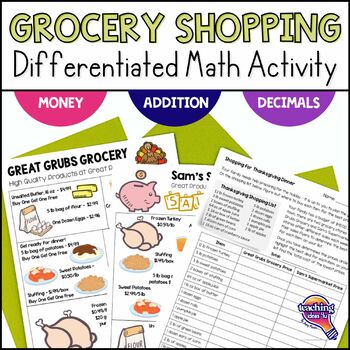Thanksgiving Grocery Shopping Math Adding & Multiplying Whole Numbers, Decimals
- PDF
What educators are saying
Also included in
- Get ready for break with our exciting bundle of Thanksgiving themed activities! These hands-on activities will keep students excited as they experiment and create, while the low -prep makes planning a snap. The lessons are flexible enough to accommodate students on different levels, allowing you toPrice $16.97Original Price $23.75Save $6.78
Description
Our Thanksgiving Grocery Shopping Math activity adds a real-world twist to learning by having students manage their grocery budget. It's suitable for 2nd to 5th graders, with three different levels (2nd/3rd, 4th, & 5th) that allow you to easily differentiate to support your students. Plus, there are extension activities like coupons and task cards to make it even more fun. The activity is included with two options, Thanksgiving dinner or family reunion, allowing you to choose the one that best meets the needs of your class.
How It Works
Students are given a grocery list and tasked with planning their shopping by comparing prices in two store ads (included.) They'll calculate the total cost of each item and decide which store offers the better deal. The activity also includes play money templates for hands-on learners.
Depending on the students' skill level, the grocery prices are in either whole numbers or decimals. The whole number activity also has two versions of the student pages - the lower level has a smaller grocery list and ads with fewer items.
Each level meets grade-level standards for 2nd/3rd, 4th, or 5th grade.
- 2nd/3rd Grade - Shorter grocery list; adding and multiplying whole numbers (1 - 12)
- 4th Grade - Longer grocery list; adding and multiplying whole numbers (1 - 12)
- 5th Grade - Same grocery list as 4th; adding and multiplying decimals to hundredths
For additional differentiation, teachers can support students by providing play money or they can extend the activity with coupons and task cards.
What You’ll Get
This resource is included on 3 levels - 3rd, 4th, and 5th grades. Each level includes:
- Student direction & worksheet in 2 themes - Thanksgiving & Family Reunion
- 2 “store ads” in color and black & white
- 1 page of “coupons” in color and black & white
- 4 task cards with extension questions in color and black & white
- Answer key for student worksheet with and without coupons
In addition, play money templates are included in both color and black and white to support hands-on learners. Templates include:
- U.S. $1, $5, and $10 bill faces
- Canadian $1 and $2 coin tails
- Canadian $5 and $10 bill faces
Why Teachers ❤️ It!
Teachers love how easy it is to differentiate this activity based on their students' needs. It aligns with grade-level standards, whether you're teaching 2nd/3rd, 4th, or 5th graders. Plus, students enjoy working on real-life tasks and seeing how math applies to everyday budgeting and saving money. You'll find yourself using this activity year after year!
Why Students ❤️ It!
Students love working on "real" tasks. They see how people use math every day to budget and save money. You will use this activity year after year!
What Teachers Like You Are Saying
⭐⭐⭐⭐⭐ My students LOVED this activity. The morning before break, I realized that I has a 90 minute period with one of my classes. I wanted to do something fun... It was EXACTLY what I was looking for to review decimals before their test the week we get back from Thanksgiving. - Megan H.
⭐⭐⭐⭐⭐ My advanced content class had the best time with this activity. Not only were they figuring out and using math skills, but they were also learning some life skills ! We talked about shopping and using coupons and which stores had the best deals. It was so much fun! They really learned something from doing this activity! – Education Depot
⭐⭐⭐⭐⭐ I used this with my homeschool daughter. She is math-averse so I am always looking for practical applications and puzzles to teach the concepts. This was perfect! We had just been planning our Thanksgiving menu, making our grocery list, planning our cooking times so our activities neatly segued into this project. She was very interested in figuring everything out and it led to several discussions about shopping and marketing. - 13 Sparrows
Save $$$ with the Bundle!
My Thanksgiving Resource thematic bundle for upper elementary includes reading, writing, science, and math activities. Keep students learning until break with 2 -3 days of high-interest activities - and give yourself time to grade and plan so you don't take work home for the holiday.
Grab your discounted bundle here!
______________________________
Copyright ©️ Amy Mezni
Permission to use with a single classroom only (one teacher).
Please purchase additional licenses if you intend to share this resource.






